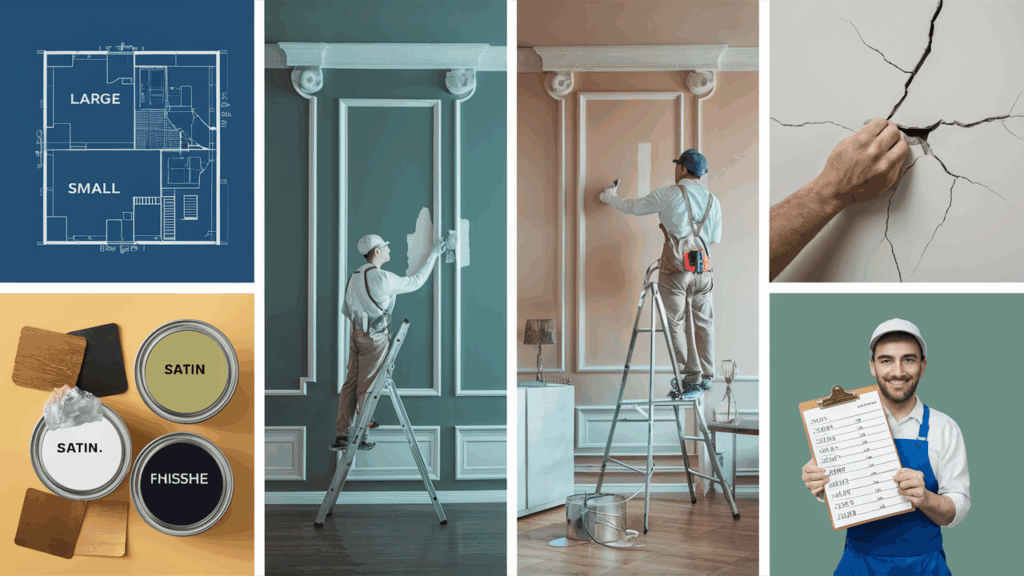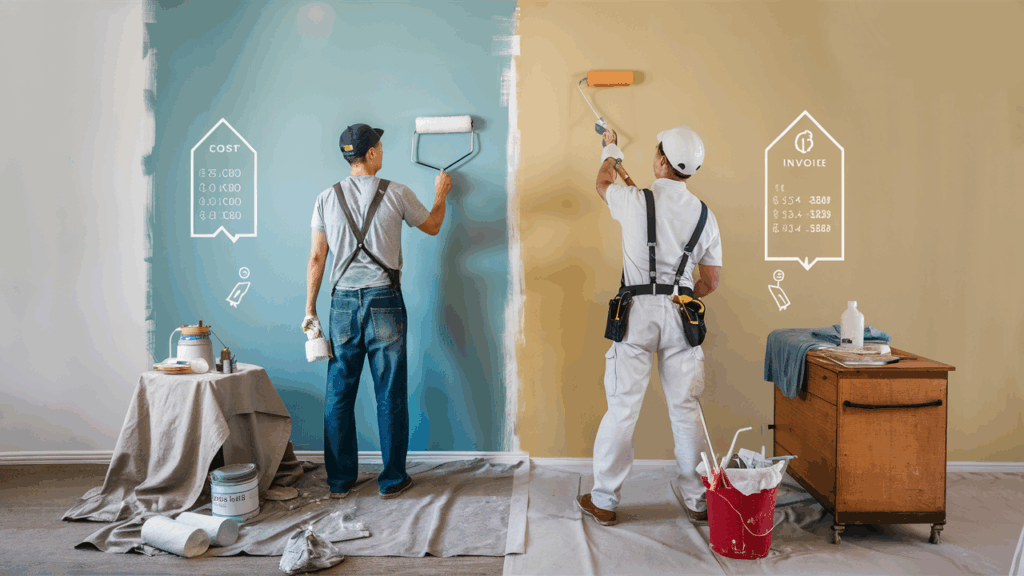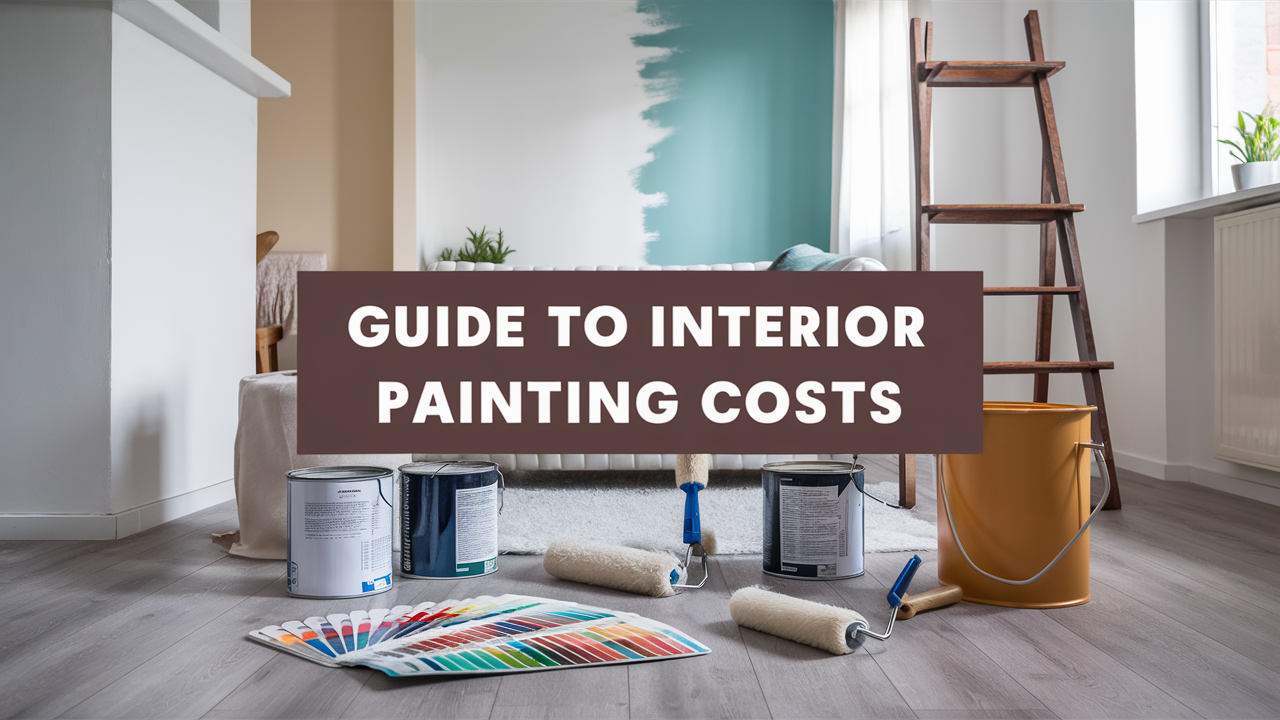Estimating the cost of interior painting can feel overwhelming, especially if you’re new to the process. In this guide, we break down the key factors that affect the cost, enabling you to understand better what to expect.
Whether you’re looking to freshen up one room or tackle an entire house, obtaining an accurate estimate is crucial for staying on budget and avoiding unexpected costs.
By the end of this article, you’ll know how to estimate painting costs confidently, whether you’re doing it yourself or hiring a professional. Trust me, understanding these costs ahead of time will make the entire process smoother and stress-free.
We’ll cover room sizes, paint quality, labor costs, and more, helping you make informed choices. Accurate estimates help you plan better and keep your home improvement project on track. Let’s get started!
Factors Influencing Interior Painting Costs

When it comes to interior painting, several key factors influence the overall cost. Let’s break them down.
Room Size and Layout
The size of the room is one of the most significant factors influencing the cost. A larger room will obviously require more paint and more time; additionally, the layout plays an important role. Rooms with odd shapes or complex designs can take longer to paint—the more work involved, the higher the cost.
Wall Height and Architectural Features
Do you have tall walls or high ceilings? This can increase both labor and material costs. The extra height means more paint is required, and it may necessitate the use of special equipment. Intricate features, such as crown molding or detailed trims, also contribute to the price. More work means more time.
Surface Condition
Walls that need repairs or preparation work will cost more. If the walls have texture or cracks, it takes time to fix them before painting. Proper prep is key to getting a smooth finish. The better the surface, the less work needed.
Paint Quality and Type
Not all paints are created equal. Latex paint is generally less expensive than oil-based paint. You’ll also find different finishes—matte, satin, or glossy—each with its price range. The quality of the paint you choose can really change the final cost.
Labor Costs
Labor is a big part of the cost. On average, painters charge between $20 to $50 per hour. Of course, this varies based on location and experience. The more skilled the painter, the higher the rate, but the work is likely to be of better quality.
Understanding these factors helps you make informed choices and keep your budget under control.
Average Cost Breakdown by Square Footage
When estimating the cost of painting your home, the size of the area is a major factor. The bigger the space, the higher the cost. Here’s a simple breakdown based on square footage:
| Home Size | Average Cost Range |
|---|---|
| 500 sq ft | $1,000 – $2,500 |
| 1,000 sq ft | $2,000 – $5,000 |
| 1,500 sq ft | $3,000 – $7,500 |
| 2,000 sq ft | $4,000 – $10,000 |
| 2,500 sq ft | $5,000 – $12,500 |
| 3,000 sq ft | $6,000 – $15,000 |
These costs can vary depending on the region and city in which you are located. For example, painting in large cities like New York or Los Angeles typically costs more than in smaller towns. Labor rates and material costs can be higher in areas with a higher cost of living.
By using this table, you can get a rough idea of what you might spend. Of course, other factors, like wall height and surface condition, will still play a role. But this is a great starting point.
Cost by Room Type
The cost of painting varies depending on the room. Some rooms cost more because they are larger, have special features, or require more time to paint. Here’s a breakdown of the average costs for different rooms in your home:
| Room Type | Average Cost Range |
|---|---|
| Living Room | $600 – $2,000 |
| Bedroom | $350 – $850 |
| Master Bedroom | $650 – $1,400 |
| Bathroom | $150 – $400 |
| Kitchen | $150 – $250 |
| Dining Room | $300 – $1,000 |
What Affects the Cost?
-
Room Size: Larger rooms require more paint and take longer to complete.
-
Room Features: Rooms with high ceilings, large windows, or detailed trim can increase costs.
-
Wall Surface: If your walls require repair or preparation work, the cost will increase.
For example, a living room with vaulted ceilings will cost more than a simple bedroom with standard walls. Kitchens and bathrooms are often smaller, but features like cabinets or tiles can make painting trickier, which could increase the cost.
This list will help you plan for the costs you can expect; however, remember that these are just averages.
Additional Costs to Consider
When estimating your painting costs, don’t forget to account for any additional expenses that may arise. These can add to the overall price. Here are some additional costs to keep in mind:
Ceilings and Trim
Painting ceilings and trim adds extra time and effort. Ceilings are often more challenging to paint, especially if they’re high. Trim work, like baseboards and molding, requires precision. These details can increase both labor and material costs.
Surface Preparation
Before painting, your walls might need some prep. If there are cracks or holes, they’ll need to be fixed. You may also need to sand and prime the surface. Repairs and preparatory work can take extra time and incur additional costs, but they’re necessary for a smooth finish.
Accent Walls and Special Finishes
If you plan to add an accent wall or opt for a decorative finish, expect higher costs. Textured walls or special techniques, such as sponging, glazing, or stenciling, require more time. These finishes require skill and can increase labor costs.
Furniture and Floor Protection
Covering your furniture and floors is essential to avoid spills. If you’re hiring a pro, they’ll likely charge for this added protection. If you’re doing it yourself, you may need to buy plastic sheets, drop cloths, or painter’s tape. Protecting your space helps keep things neat, but it can add to the overall cost.
These additional costs are often overlooked, but they can significantly impact your budget. Keep them in mind when planning your painting project.
DIY vs. Professional Painting: Cost Comparison

When it comes to painting your home, you have two choices: do it yourself (DIY) or hire a professional. Both have their pros and cons. Let’s break down the costs and decide which is the best fit for your project.
DIY Costs
If you decide to tackle the painting yourself, here’s what you’ll need to buy:
| Item | Estimated Cost |
|---|---|
| Paint (per gallon) | $30 – $80 |
| Brushes and Rollers | $10 – $50 |
| Drop Cloths and Tape | $10 – $30 |
| Sandpaper and Primer | $20 – $60 |
| Ladder or Extension Pole | $30 – $100 |
Total DIY Estimate: $150 – $300 (for a small room)
You can save on labor, but the costs of tools and supplies add up. Plus, painting will take more of your time.
Professional Painting Costs
Hiring a professional painter typically includes both labor and materials. On average, here’s what you might expect:
| Item | Estimated Cost |
|---|---|
| Labor (per hour) | $20 – $50 |
| Paint and Materials | $30 – $80 per gallon |
| Total for Small Room | $600 – $2,000 |
Total Professional Estimate: $600 – $2,000 (for a small room)
Professionals bring experience, speed, and quality. However, the cost is higher due to labor and overhead expenses.
Pros and Cons
DIY: The benefits of doing it yourself include lower costs, full control over the project, and a sense of accomplishment upon completion. You can work on your schedule and take your time with the project. However, there are also cons to consider.
Painting yourself can be time-consuming, and there’s a risk of making mistakes that could affect the final result. The work may not be as polished as professional work, and you’ll also need to invest in tools and supplies, which adds up.
Professional: Hiring a professional has several advantages. You’ll get high-quality work and a faster completion time. You won’t have to deal with the mess or stress of painting, and professionals have the skill and experience to handle complex tasks.
On the downside, the cons include the higher cost and a lack of control over the project. Scheduling can be challenging, and you may need to wait for the painter’s availability. Plus, you won’t get the satisfaction of doing it yourself.
When to Choose Each Option
-
Go DIY if you have time, enjoy hands-on projects, and want to save money.
-
Hire a professional if you’re short on time, want a flawless finish, or have a large or complex project.
Both options can be effective, but it depends on your specific needs, budget, and the scope of your project.
Tips for Getting Accurate Estimates
When you’re getting your home painted, it’s essential to ensure you’re getting a fair deal. Here are some tips to help you get accurate estimates.
Obtain Multiple Quotes
Don’t settle for the first quote you get. Get at least three estimates from different contractors. This provides a clearer understanding of the average cost and helps you identify any outliers.
Check References and Reviews
It’s essential to verify the credibility of the painter. Request references and verify online reviews. If a contractor has good reviews and satisfied customers, that’s a good sign. Don’t skip this step—it can save you from hiring the wrong person.
Clarify Scope of Work
Be clear about what you need. Define the project details upfront, including which rooms to paint, the types of finishes you want, and any additional work, such as repairs. The more specific you are, the more accurate your quote will be.
Understand Warranty and Guarantees
A good painter should offer a warranty or guarantee on their work and the materials. This protects you in the event of a problem after the job is completed. Be sure to ask about this before you sign any contracts.
By following these tips, you can obtain a more accurate estimate and avoid unexpected costs later on.
Conclusion
Estimating interior painting costs doesn’t have to be overwhelming. By considering factors like room size, wall height, and surface condition, you can get a good idea of what to expect. Don’t forget about additional costs, such as painting ceilings, trim, and preparing surfaces. Whether you choose to DIY or hire a professional, understanding these factors will help you make the best decision for your budget and needs.
Careful planning is key. Be sure to get multiple quotes, check references, and clarify the scope of work. Also, ensure you understand any warranties or guarantees that are offered.
If you’re still unsure or require a more precise estimate, please don’t hesitate to contact us for a personalized quote. We’re here to help you with your painting project every step of the way!
Frequently Asked Questions
How Long Does It Take to Paint a Room?
The time it takes depends on the room size and complexity. On average, expect about 1-2 days for a single room.
Can I Paint Over Old Paint?
Yes, but the surface may need to be cleaned, sanded, and primed first to ensure proper adhesion for the new paint.
What’s the Best Paint Finish for Interior Walls?
Matte or eggshell finishes are often preferred for interior walls as they hide imperfections and are easy to clean.

